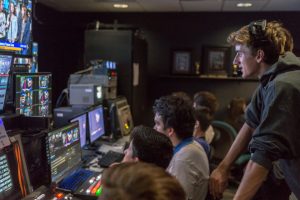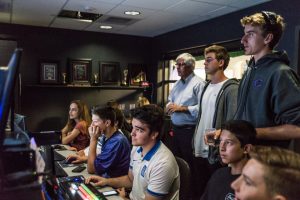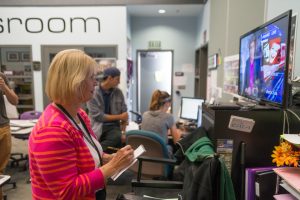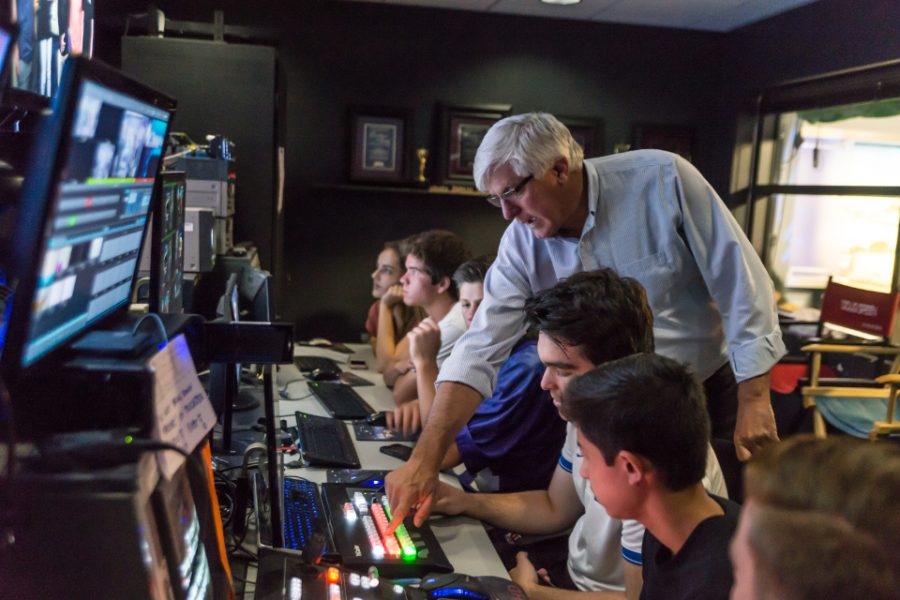Reporting live from Carlsbad High School: A spotlight on CHSTV
CHSTV adviser Doug Green instructs students before a live broadcast on Oct. 13 at Carlsbad High School. (Photo by Troy Orem)
October 18, 2016
“You’re confident about that nine-minute run time?”
The producer speaks rapidly into his headpiece as he surveys the rundown for the morning’s broadcast. He waits for a response from one of his associates before checking his watch.
“OK, guys,” he says, loudly enough for everyone to hear. “Twenty seconds.”
There is a flurry of activity as everyone prepares for the live broadcast. A sound technician double checks mic batteries; the anchors shift in their seats to face the correct cameras. The producer speaks again.
“Ten seconds. Don’t screw up.”
Precisely 10 seconds later, the morning broadcast begins and the anchors welcome viewers to their show for Thursday, Sept. 15. The show flows seamlessly from in-studio reports to offsite live interviews to pre-recorded packages. It is, for all intents and purposes, a professional, well-executed broadcast — with one difference: The entire crew, from producer to news anchor, is comprised of high school students.

The Carlsbad High School news channel — CHSTV — is not the first of its kind, but it is one of the best. The Student Television Network (STN), a national organization dedicated to supporting and promoting scholastic broadcast journalism, has named CHSTV the winner of its Award of Excellence in the “Daily, Live” category five consecutive times between 2008 and 2013.
Educator Doug Green created the broadcast program at Carlsbad High School in 2001, and Green says the timing of the launch was perfect.
“That was just when we were going away from the old school editing system, where you required a lot of editing equipment,” he says. “Where an editing system in 1998 would cost $15,000, a few years later you could buy 15 of these (systems) for $15,000. So we hit the digital revolution just perfectly and that program right away won some national awards and Disney was looking at it as a possible sitcom.”
The program immediately gained popularity, and today, the application process to join the CHSTV team is highly competitive; the number of freshmen admitted at the beginning of a school year is based on how many seniors graduated the year before.
Applicants must complete a minimum of one broadcast course in middle school and submit two original videos for consideration: a music video and an investigative piece. Once accepted, students are part of CHSTV for the entire four years of their high school career.

Junior Lillian Koch’s application package included an investigative story on the controversy over pit bulls.
“It’s a very hard application,” she says. “But it’s a great program.”
CHSTV’s focus, Koch says, is stories that affect students at Carlsbad High. “We really try to focus on new students,” she says. “We’ll do Lancer of the week or athletes of the week.”
Sometimes, though, it will branch out to cover local community news. The students work in two-person teams to film, edit and produce an air-worthy package.
According to Koch, last year, CHSTV covered the controversial story of yes-or-no on Measure A, a proposed measure to build a multistory shopping mall on Carlsbad’s Agua Hedionda Lagoon. The measure generated high interest from the community and was campaigned heavily for and against. When the measure went to the ballot box, it was defeated 52 percent to 48 percent.
“We got an interview with (developer Rick) Caruso and all the people opposed to it,” Koch says. “So it was really interesting seeing everyone’s side to it.”

Typically, Green says, his team of student journalists doesn’t shy away from edgier stories. In addition to their daily broadcasts, his students have produced three documentaries. Their most recent documentary was on vaccines and the science of the body’s immune system.
“It wasn’t pro- or anti-vaccine; we simply looked at how the body works,” he says. “But we took a lot of heat from anti-vaccine people who said, ‘You’re corrupting your students; your kids have clearly been bought out by the pharmaceutical companies.’ We weathered out the storm and it was really scary for a while. But these kids learned that if you go into this business, you have to have a thick skin and you have to cover all your bases.”
Green says he feels this type of project-based learning program is more effective than the traditional classroom setting and gives students real-world experience while in the controlled environment a classroom offers.
“It’s academic (and) it’s rigorous; but it’s a lot of fun,” he says. “You have a front row seat to life.”
Michele Leivas is a San Diego freelance writer




